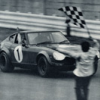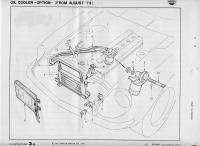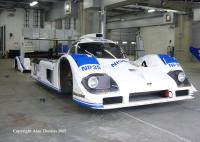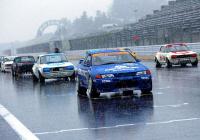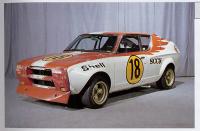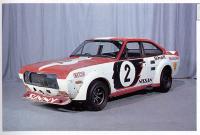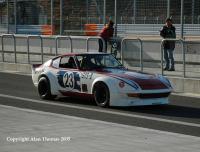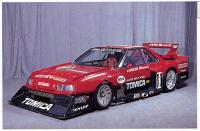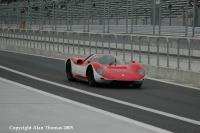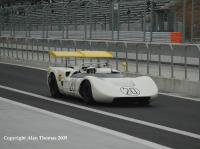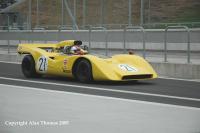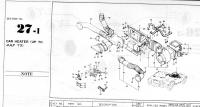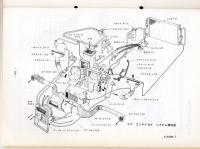Everything posted by HS30-H
-
L 24 engine
-
#682 on e-bay
You've got the codes mixed up. 'S30-S' = Fairlady Z ( 'Z STD' or 'S' model to the factory ). This was the super-basic 'no frills' model. Rubber mats, no hubcaps and plain bumpers etc....... 'S30' = Fairlady Z-L ( 'Z Deluxe' or 'D' model to the factory ). This was the 'Luxury' version with carpet, hubcaps, rubber bumper trim and a free copy of the theme to 'Man In a Suitcase' on 12-inch vinyl.
-
Classic Motorsports "top 10" Japanese Race Cars of all time!
As I mentioned before, this is not my personal all-time 'Top 10'. In fact, I don't think any of the particular cars I posted would be in my all-time top ten of Japanese race cars....... The list is intended as a practical suggestion for vehicles that are of historic interest, currently running, owned by either Nissan or NISMO in Japan, and could feasibly be taken anywhere in the world to be demonstrated.
-
Classic Motorsports "top 10" Japanese Race Cars of all time!
Next: Nissan NP35 - this closed-roof sports car was built in-house at NISMO for the 1992 JSPC. Its 3.5 litre normally-aspirated VRT35 V12 DOHC engine produced 630ps at over 12,000 rpm is a joy to hear on song. I selected this car because it is unique, it is running and active, and I think it is absolutely beautiful. Killing two Skylines with one stone: The KPGC10 Skyline GT-R was the model that brought the majority of wins in the GT-R's famous '50 Victories'. I think it needs very little explanation here, and surely an American ( or Australian, NZ, European, British..... ) audience would love to hear a race-tuned S20 engine on song? I don't suggest any particular car here, as privateers in Japan have some of the cleanest and fastest examples that are still active. The CALSONIC-sponsored Group A Nissan Skyline GT-R needs no intro here either. The CALSONIC-liveried cars were always the hottest Works entries with the latest updates and the most powerful engines. They also had - arguably - Nissan's hottest drivers at the wheel. They won so many races that the series had to have its rules changed. I watched these things make RS500 Cosworth Sierras and BMW M3s look like pedal cars at tracks like FISCO, Sugo, Tsukuba and Suzuka. They still look fast today. The CALSONIC-liveried cars are probably the most readily recognised, but the TAISAN / STP and Reebok liveried cars ran close, along with a gaggle of others. Not forgetting the 'Winfield' sponsored examples in Australia either. Again - as I have tried to make clear - the list I made consists of cars that COULD be taken anywhere in the world and run with little problem. Totally academic considering Nissan's intransigence, but a practical suggestion nonetheless........
-
Classic Motorsports "top 10" Japanese Race Cars of all time!
Next group: Nissan Cherry X-1 ( KPE10 ) - this car competed in the 'TS' race of the 1973 Japan Grand Prix meeting. Its A12 4-cylinder OHV engine was a low-tech 'screamer', and the TS races were where Nissan duked it out with their rivals at Toyota. Nissan Sunny Excellent ( KPB110 ) - this car was the winner of the 'TS' class race at the 1973 Japan Grand Prix meeting. Its 16-valve DOHC LZ14 engine was essentially a Formula Pacific race engine, producing 200ps on Nissan's 'ECGI' injection setup at over 10,000 rpm. Again, this class was the arena where Nissan fought their battles with Toyota - winning hearts and minds on the race track in the hope of winning sales in the showroom. Fairlady 240ZR ( HS30 ) 1973 - this car has a slightly mysterious history, but was built as a full 'Works' Group 4 'aerodynamic' race car in-period. It ended up as one of the Nissan Racing School fleet of pensioned-off race cars and then sat in NISMO's collection for many years. A few years ago it was restored by NISMO, and it features many trick original Works parts - such as its 'LY28' SOHC crossflow engine. The car is painted to replicate a famous livery used by the Works cars in period. Now usually driven at NISMO events by arch exponent of the S30-series Works circuit race cars Mr Haruto Yanagida ( of 'Central 20' renown ) who still drives with verve and excellent speed. Skyline Super-Silhouette - ( KDR30 ) Tomica / Hasemi Motorsport - this car should need no introduction. Built for the short-lived 'Super Silhouette' formula in 1982/83 - this car dominated the series. Its LZ20B engine was turbocharged to produce 570ps and a distinctly on/off nature ( whilst spurting huge flames from its side muffler outlet )that led to the necessity of a unique driving style from pilot Masahiro Hasemi.
-
Classic Motorsports "top 10" Japanese Race Cars of all time!
OK Ron, here is my list again - this time to follow up with photos and brief explanations: *R380-II - GR8 engine - 1967. *R381 - Chevrolet V8 engine - 1968. *R382 - GRX-3 V12 engine - 1969. *Skyline GT-R ( KPGC10 ) - S20 engine - 1971. *Cherry X-1 ( KPE10 ) - A12 engine - 1973. *Sunny Excellent ( KPB110 ) - LZ14 engine - 1973. *Fairlady 240ZR ( HS30 ) - LY28 engine - 1973. *Skyline Super-Silhouette - ( KDR30 ) - LZ20B engine - 1983. *NP35 - VRT35 NA V12 DOHC engine - 1992. *Group A Calsonic Skyline GT-R ( BNR32 ) - RB26DETT engine - 1993. First photo is the recently-refurbed Nissan R380-II pictured at the last NISMO Festival, which took place in December 2005 at Fuji Speedway in Japan. This car is claimed to be the actual car that set a great number of international speed records at Yatabe in 1967 ( the second record-breaking run for the R380 at Yatabe ). Second is the also recently-refurbed Nissan R381, again pictured at the 2005 NISMO Festival. This car is the 1968 Japan Grand Prix winner, and the innovative twin-pitching 'active' rear wing is fully functional. Third up is the Nissan R382, which was rebuilt a couple of years ago. This car is the 1969 Japan Grand Prix winner. The 6-litre GRX-3 V12 DOHC engine had to be built up from several display engines that had not run for over thirty five years.
-
Classic Motorsports "top 10" Japanese Race Cars of all time!
Ron, This thread seems to have very little in common with its title now. And that's not a complaint, that's an observation. In view of the fact that the thread has turned into a plea for Nissan's participation in / sponsorship of an American 'historic' car event, I came up with the following: OK, here's a list of TEN cars. All of them are currently owned by Nissan and NISMO in Japan, and all of them are in running order and can be demonstrated at something close to full racing speed on a race track. They would need to be brought over from Japan to the USA along with a skeleton staff of mechanics and spares to run them, but I would not have thought that this was an unsurmountable problem logistically or financially. They might need two or three Japanese drivers that are familiar with them too. I would choose Moto Kitano and Haruto Yanagida, as between them they have driven the majority of these cars either in period, or at Japanese events within the last few years. These two are part of Nissan's racing heritage ( whether they like it or not ) and ought to be interviewed by a few English-speaking journalists before they forget more than they remember...... *R380-II - GR8 engine - 1967. *R381 - Chevrolet V8 engine - 1968. *R382 - GRX-3 V12 engine - 1969. *Skyline GT-R ( KPGC10 ) - S20 engine - 1971. *Cherry X-1 ( KPE10 ) - A12 engine - 1973. *Sunny Excellent ( KPB110 ) - LZ14 engine - 1973. *Fairlady 240ZR ( HS30 ) - LY28 engine - 1973. *Skyline Super-Silhouette - ( KDR30 ) - LZ20B engine - 1983. *NP35 - VRT35 NA V12 DOHC engine - 1992. *Group A Calsonic Skyline GT-R ( BNR32 ) - RB26DETT engine - 1993. Now, who wouldn't want to see that group fired up and driven hard? This is not my "Dream Team" by any means; I could easily come up with a list of over 100 Japanese race cars that I would like to see driven hard on a race track once again - but 95% of them don't exist any more. The remaining 5% still exist but are not all in full running / racing order. That list would only start to approach the title of this thread, and it would be fun to discuss - but I'm trying to be practical here. The above ten cars COULD be sent virtually anywhere in the world to be demonstrated. Probably too late for the Mitty, but people need to be lobbying NOW for events two or three years in the future. Many of the major auto manufacturers in the world now participate in events such as these, and do it as a part of their advertising and promotions budget. The current regime at Nissan need to do it too. Even one or two special ( rarely seen / historic ) cars would be better than nothing, and would generate many column inches of free coverage that would otherwise have to be paid for. Nissan are still struggling internally over matters such as these ( and they still don't have a proper museum in their homeland ) but they need to catch up with their peers and the time to start is now. Alan T.
-
1st gen seats
Just to follow this up - I have searched for the part numbers of the seat cushion 'guards' and I too drew a blank. The earliest Japanese parts lists I have ( dated November 1969 ) show them in the illustrations but don't give part numbers. This is surprising, as just about every other single nut, bolt and component of the seats is listed. Same situation with the RHD Export parts lists. The Japanese market 'Service Shuho' booklets ( issued to the dealers to clue them up on the new models ) also have illustrations that explain the seats and their workings. The seat guards can be seen, but are not mentioned. My *guess* is that they were already decided to be surplus to requirements by the time the parts catalogs, Service Shuho booklets and factory workshop manuals were being compiled. But I'll keep my eyes open.
-
Classic Motorsports "top 10" Japanese Race Cars of all time!
Ron, Don't take this as a personal dig, but I notice you don't have a single Japanese-prepped / Japanese-driven / 'Works' purpose-built race car in your list......... Every single car in your list appears to be a car modified from a standard production road car - as opposed to a limited-run homologation special or 'real' ( read: purpose designed ) race car. They also all appear to be cars that raced exclusively in the USA. OK - so the purpose behind this is to lobby the organisers of the Mitty to include ( invite / sponsor / subsidise? ) some certain cars in their event, and we have to take the thread title with a pinch of salt - yes? Therefore it would ( surely? ) be a good idea to lobby for cars that actually still exist........, and have a good chance of showing up should they be invited - yes? But still, it would be nice to see some cars from outside the USA domestic race scene being included in a list with the title "10 Best Japanese Race Cars of All Time.".......... I think that needed to be said. Good luck all the same. Alan T.
-
A/C for '73, factory or dealer installed?
Well, it looks to me as though the original Japanese market system would not be a 'bolt-in' fit to the first LHD cars. The heater casing of the pre-August 1973 LHD cars has its inlet duct on the right, the fan housing is on the right and the air intake from the cowl is also on the right. The LHD cars would therefore need their own design of air conditioning components rather than sharing the Japanese market parts. Well, the illustrations I scanned and posted above are from the June 1974 issue Factory Parts Catalog for the 'Datsun 260Z. 240Z, model S30 series, USA & Canada' ( Nissan Pub. No. C-001OU ). Section 27 ( 'Car Heater up to July '73' ) has 5 pages of illustrations showing the inlet duct and fan housing on the right. Section 27A ( 'Car Heater from August '73 ) has 7 pages showing the inlet duct and fan housing on the left. The same manual also has the ( new for August '73 ) Air Conditioner system illustrations in Section 29 ( three pages on the interior components ) and these all show the inlet duct and fan housing on the right........ Does this mean that the illustrations in Section 27A are actually wrong? No, but then why would it ever need to be? I mentioned it because I thought it might be significant. I saw the illustrations showing the - apparent - movement of the air duct and fan housing right at the date the Factory air con system was phased in on the LHD models. All of this would be easy to put to rest straight away if the illustrations in section 27A of the parts catalog are incorrect. I've seen a few little mistakes in other Nissan parts catalogs and workshop manuals for the S30-series Z, but this one is a biggie and I've never seen any reference to it. But going back to my original point - the Japanese market got the option of an air conditioner system designed for the ( RHD layout ) car and it was available right from the beginning of sales in late 1969. The USA & Canada market on the other hand ( a market that included territories where I would have thought an air con system was de rigeur ) did not get this until August 1973. In the meantime - ie from early 1970 to late 1973 - some dealers and private owners in the USA were fitting aftermarket air con systems to their cars. That's a long time. Especially when the Japanese market ( which gets very hot and humid in Summer ) had a perfectly good system designed for the car and available Factory-fitted as a specifiable option. Surely it would have been simple for Nissan to incorporate a Factory-fitted air con system into the LHD cars from the beginning of production? Why didn't they do that? I have my own theories, but I'm interested to hear what anybody else thinks. Alan T.
-
A/C for '73, factory or dealer installed?
That's not what I see in the Factory parts catalogs for the LHD models. Look at these two scans. First is 'up to July '73', second is 'From August '73'. Blower motor and Intake Duct etc clearly moves from the left side of the dash to the right in July / August 1973 on LHD cars. Please tell me I'm not going nuts..........
-
A/C for '73, factory or dealer installed?
Hi Stephen, As far as I understand it ( certainly looking at the Factory parts catalogs for the LHD models ) the complete layout of the LHD heater system changed in July / August 1973. Previous to July August 1973 the blower unit was under the RIGHT hand side of the dash on LHD models ( as opposed to the LEFT side of the dash on RHD models - as illustrated in the scan I posted ), and post July / August 1973 the blower ( and all its attachments ) moved over to the LEFT side of the dash - just like the RHD models. Am I right?
-
A/C for '73, factory or dealer installed?
For reference purposes: Scan from the Nissan 'Service Shuho' booklet no.184 ( the first for the S30-series Z ) which introduced the new model series to the Japanese dealers. Dated November 1969:
-
A/C for '73, factory or dealer installed?
As a matter of fact, the S30 was designed to incorporate an air conditioning system. The Factory was fitting a very comprehensive system right from the beginning of sales to the general public in late 1969. Of course this was on Japanese home-market models, and not the HLS30U. Whether it actually worked as well as some people would have liked is another ( different ) discussion. Another interesting discussion might be whether the original Factory air conditioning system was not offered on the HLS30U because it was designed for an RHD configuration, and only an RHD configuration - which would be interesting..........
-
NISMO grill install in a post 7-72 240
To clarify the clarification: The mesh grill that gogriz91 has purchased is the same type as those fitted to the S30 ( 'Fairlady Z-L' ), S30-S ( 'Fairlady Z' ) and PS30 ( 'Fairlady Z432' ) from the start of production in 1969. All three models had the same size mesh gauge. It was the PS30-SB ( 'Fairlady Z432-R ) that had the different gauge mesh, and this part has been discontinued for more than 30 years now. No, it is a stock Nissan part - just like the originals were in 1969. To expand on this a little, Matsuo says it was the 'bean counters' who foisted the use of the mesh grilles on the home-market models due to cost cutting. However, this makes it sound as though the mesh grilles were created simply to cut costs - which was not the case..... In fact, the 432-R model was always going to have a mesh grille, as the slat-type grille would have laid its large oil cooler ( mounted in front of the radiator ) open to stone damage. The 'bean counters' pinched the low-cost mesh grille and imposed it on the other home-market models - but with a different mesh gauge. True story.
-
Oldest car to wear GT-R badge
Lachlan, The Isuzu Bellett GTR ( with the G161W engine ) didn't debut until September 1969, a full six months after the PGC10 Skyline GT-R. I think you are possibly getting your GTs mixed up with your GT-Rs?
-
Son of DAT
26th-Z, Have you any idea what Katayama meant exactly when he described the 'Datsun' name as having "purity"? I certainly don't see how the 'Datsun' brand lineage could be described as "pure"', especially if this is implying that the 'Nissan' company lineage was in some way 'impure'. Sounds to me more like Katayama politics than anything else. I'd be interested to hear otherwise.
-
skyline on ebay!!
What I find amazing about this auction is that the vendor has the balls to write this: "Up for auction is a very desirable 1972 Skyline GTR." The auction title also states: "1972 Nissan GTR". If that isn't the most blatant misrepresentation then I don't know what is. Only Nissan could make a GT-R. Nobody can take a GT-X, swap a few parts around and call the car a 'GT-R' - especially without the S20 engine. Shocking.
-
Barrett Jackson Auction, Scottsdale
You are definitely on the wrong thread, d***. This is the 'Carl Beck Big-Ups His Dune Buggy' thread.........
-
L-series Engine
I'm not happy to have that kind of sobriquet applied to me, even if it is meant kindly. It makes it look as though I might even believe it myself - which is for sure not the case. Of course there is an absolute wealth of things that most of us don't know about the history of these cars and the companies and individuals that made them. It is a great challenge, and any fresh information that we glean tends to open up the possibility of further questions we hadn't even thought of. And so it goes on...... But where the information is already at hand ( as in the case of the genesis of the Nissan 'L-gata' engine ) it would be nice if it was passed around properly and recorded correctly. But instead we have advertising copy and sales flannel taken as gospel. It is very frustrating. Unless you can type his full name into the Japanese search engines ( in Kanji or possibly Katakana ) you probably won't get much in the way of results. The World Wide Web is not necessarily the fount of all wisdom just yet....... Perhaps you shouldn't expect too much from it. You'll have to immerse yourself in some Japanese books and old magazine articles to satisfy some of your curiosity about the man. Alan T.
-
L-series Engine
Agreed. The L-gata was a Nissan in-house design, and was not a direct relation to anything from Prince. The S20 was Nissan's development from the Prince GR8 ( not the G8 ). First the Prince GR8 was re-badged the 'Nissan GR8', and then the Nissan S20 engine was developed. The S20's DNA was from the GR8, but it was effectively a completely new design. To make a direct link between the S20 and the RB-series engines is a little misleading. There's a stepping stone between them, and that stepping stone was the FJ-series. The FJ was effectively a four-pot successor to the S20, and shared many design details. There are even some valvetrain components which are interchangeable. The RB-series was conceived as a practical successor to the L-series, and the RB26DETT ended up as a spiritual successor to the S20. There is a certain amount of 'what comes around goes around' in the story, as the Nissan L-series engine debuted with the L20 six in the H130-Series 'Cedric Special Six' - a top of the line Sedan. The RB-series engine debuted in the 1984 Laurel - also a top of the line sedan. Head of the design and development team for the RB-series engine was Mr Shinichiro Sakurai - the man ( sometimes known as 'Mr Skyline' in Japan ) who had overseen the motorsport activities of Prince, and who was the chief engineer overseeing the design and development of the GR8, S20 and FJ-series engines. That's quite a blood line. How often do we read and hear that the Nissan L-series engines originated with the L16 of the 510 Bluebird? It is an oft-repeated mistake, and has now become all but set in stone. Of course it is a completely FALSE story ( most likely originating in American advertising for the HLS30 ), as the 4-cylinder versions of the L-series engine came after that L20 six in the H130 'Cedric Special Six'. Designer / Chief Engineer of the L-series engine? Mr Hiroshi Iida. We really ought to remember his name and sing his praises more often than we do........ Alan T. ps - sakijo: Thanks for starting this thread.
-
L-series Engine
Please don't take this personally, but I think your 'family tree' is dysfunctional...... It makes it look as though Nakajima ( note the spelling ) and Tachikawa came before most of the companies listed below them ( which is not the case ) and it also makes it look as though the Nissan Motor Co. Ltd. didn't exist until PMC was merged with it - which is also not the case. Please also note the spelling of 'Kaishinsha' ( it is not 'Kwaishinsha' ) and in fact it would be more accurate to split it into two words; 'Kai Shinsha'. And what's with the inclusion of 'Infiniti' ( it makes it look as though 'Infiniti' is a company all on its own, and is the result of all that went before it )? Like I said, please don't take it personally. I just think it is dangerous to make family trees like this when the story is a lot more complex and convoluted than such a graphic device can portray. Alan T.
-
L-series Engine
John, I don't see any accurate information / history on Nissan's L-series engine on zhome.com..... Can you tell me whereabouts on the site it is located? I agree wholeheartedly, Victor. The whole thing smacks of received prejudice.
-
Clip of a Rally edition 240Z
Yes thanks, and it worked just fine with RealPlayer when I right-clicked and 'saved as' from the streamload.com address too. Cheers, Alan T.
-
should all 240's have rear sway bars
Come on Gav, you have to do better than that! We've covered this question many times in the past on this Forum...... There were '240Zs' fitted with rear anti-roll bars from the Factory, and there were lots of other S30-series Z cars ( Fairlady Z, Fairlady Z-L, Fairlady 240Z, Fairlady 240Z-L, Fairlady 240ZG, Fairlady Z432 & Z432-R for example ) that had them fitted from the Factory, or could specify them at time of order too. It was the USA market that was odd man out in this case.




